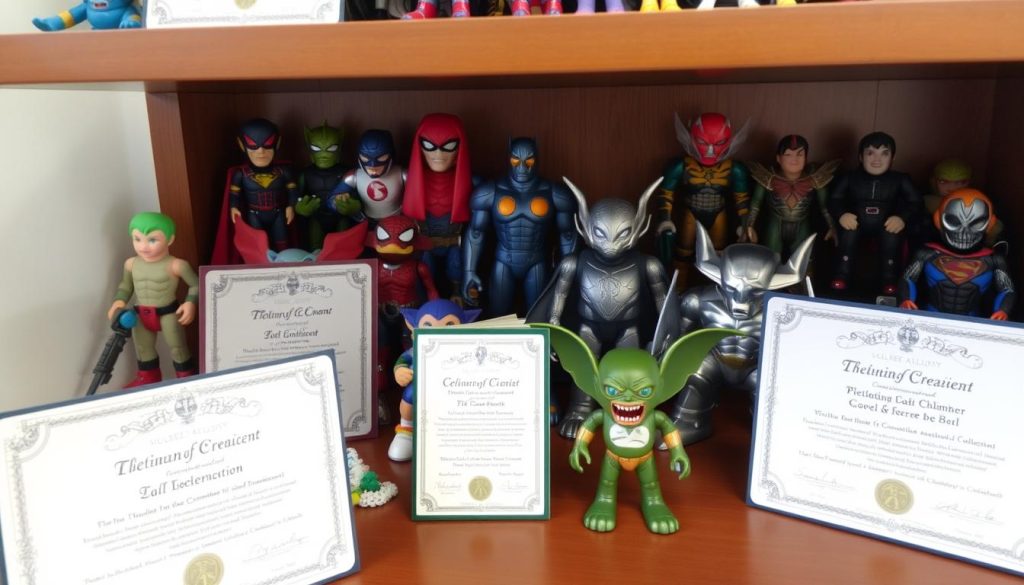Collecting toys and products with verification adds massive value. It also makes sure your collection is legit. Certificates of authenticity are key here.
These certificates prove that the collectible is real, as checked by its maker or a trusted third-party. Since an item’s rarity and originality define its price, having this proof can really up its value.
Well-known brands like LEGO and Funko give out these certificates for their special items. This helps keep the collecting world safe from fakes. It builds trust among collectors, auction houses, and people who resell.
Key Takeaways
- Certificates of authenticity are essential for confirming the legitimacy of collectible toys.
- They provide provenance and verify that an item is not counterfeit.
- These certificates can significantly impact an item’s monetary value.
- Brands like LEGO and Funko often issue certificates for their special releases.
- The presence of certificates reduces the risk of fraud in the collectibles market.
- Maintains trust among collectors, auction houses, and resellers.
Understanding Toy Authenticity
In the collectible world, making sure a toy is real is very important. Knowing a toy is authentic, not a fake, gives collectors confidence and value over time. Here, we delve into what makes a toy authentic and the features that prove it’s real.
What Does Toy Authenticity Mean?
Toy authenticity means checking if a toy is officially made and released by the actual maker. Authentic toys don’t have any fake parts, ensuring collectors get true, certified toys. Be it old Star Wars figures or special Barbie dolls, knowing a toy is real is key to protecting your collection.
Key Features of Authentic Toys
To spot real toys, look for specific features. They include:
- Materials that meet the maker’s high standards.
- Signs from the maker, like logos and special stamps.
- Unique numbers, barcodes, or holograms for extra proof.
- Labels and branding that are correct for special editions.
- For real rare items, artist signatures or unique marks show limited production.
Certified toys have these signs of authenticity, marking them as true pieces in a collection. Collectors should get to know these signs to easily tell if their items are real.
The Role of Certificates of Authenticity
For both collectors and sellers, authenticity certificates are vital in the collectible toys market. They confirm an item’s origin and rarity, proving it’s legally made.
Purpose of Authenticity Certificates
Certificates of authenticity are key for many reasons. They prove a toy’s history, making sure it’s real. They help check for authenticity and give collectors peace of mind about their buys.
How Certificates Are Issued
The process for issuing certificates starts when a toy is made or sold. Makers or licensors strictly check if a toy matches their standards. For exclusive toys, numbered certificates show their limited series status. This ensures their value as collectibles later on.
Benefits of Having Authenticity Certificates
Toy collectors benefit a lot from having authenticity certificates. As more people get into collecting, the value of these documents becomes clear. They help keep the worth and history of collectibles safe.
Protecting Your Investment
Certificates are key for *investment protection*. If a toy is lost, stolen, or damaged, a certificate can safeguard your money. Insurance companies also ask for them to back up claims. This adds an extra safety net for your investments.
Boosting Resale Value
Having a certificate can boost a toy’s *resale value*. Buyers will pay more for items that are verified. This means sellers can get more money, showing how valuable certificates are.

Trust and Credibility in Collecting
Certificates also add to *collecting credibility*. They make transactions between buyers and sellers clear and honest. This helps keep the collectible market fair. It also builds a good reputation for everyone involved, making collecting more trustworthy.
| Benefit | Impact on Collectors |
|---|---|
| Investment Protection | Ensures financial security through documentation needed for insurance claims. |
| Resale Value | Increases the monetary worth of the toy in the secondary market. |
| Credibility | Fosters trust between buyers and sellers, enhancing the reputation of collectors. |
Authenticity certificates are crucial for serious collectors. They protect investments, raise resale values, and confirm credibility in the community.
Identifying Fake Toys and Certificates
It’s crucial for collectors to avoid fake toys and counterfeit certificates. You should look closely at the toy’s details and know the signs of fakes. Checking a toy’s authenticity protects your collection.
Common Signs of Counterfeit Toys
Fake toys usually don’t look right. They might have poor quality, wrong colors, misspelled names, or missing details. Check the packaging and look for official logos to spot fakes.
Evaluating the Certificate of Authenticity
Evaluating certificates carefully is key. A real certificate uses high-quality paper, has official signatures or stamps, and includes safety features like holograms. Watch out for fake certificates that have errors, poor printing, or are missing important info like serial numbers.
| Indicators | Authentic Toys | Counterfeit Toys |
|---|---|---|
| Craftsmanship | High-quality, detailed | Poor-quality, lacking detail |
| Colors | Accurate | Incorrect |
| Branding | Correctly spelled | Misspelled |
| Packaging | Contains official logos | Missing official logos |
| Certificate Paper Quality | High-quality, including security elements | Low-quality, lacks security elements |
| Certificate Information | Serial numbers, issuing authority | Lacks crucial information |
Best Practices for Collectors
For collectors aiming to check their toys’ realness, following top advice is key to protecting their investments. This step not only keeps the collection’s value but also boosts respect among collector groups. Here are some key tips to remember.
Where to Obtain Certificates
Getting real certificates from trusted places is crucial. Collectors should go to official brand stores, approved sellers, or straight from the makers for these documents. This assures the certificates are real and accepted everywhere. Big names like LEGO, Hasbro, and Mattel offer genuine certificates for special or collectible items.
Maintaining Documentation
Keeping detailed records is also very important. Collectors should save receipts, copies of certificates, and full descriptions of their items. These documents prove the items are real. They also track the history of what you own, which is great for selling later or for insurance needs.
Resources for Verifying Toy Authenticity
Using different resources to check if toys are genuine helps collectors a lot. Look into databases for collectibles, ask experts on forums, or use services from big grading companies like Collectors Universe or CGC (Certified Guaranty Company). Also, connecting with other collectors, joining clubs, and keeping up with trusted collecting news are smart ways to get better at knowing if toys are real.

